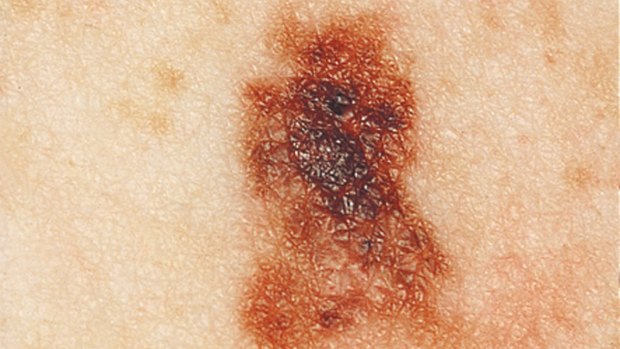By Jared Lynch
A team of German software engineers is hoping to slash the rate of skin cancers in Australia by putting the intelligence of so-called smart phones to the test.
Lifespot Skin AG, has created pattern recognition technology, which works with a medical data base to detect a range of skin ailments, including cancers.

A typical image of a thin, invasive melanoma.
The company is hoping to list on the ASX mid this year, via a $6 million capital raising to complete the development of its smart phone app.
It is targeting Australia rather than its home market because executive director Tilo Brandis said the country had twice the rate of skin cancers as anywhere else in the world and a low ratio of patients to dermatologists.
"Germany has 80 million people with 5600 dermatologists. To compare that with Australia, you have 20 million people – about one fourth of the population with less than 10 per cent of the dermatologists," Mr Brandis said.
"The area of Australia is 20 times larger than Germany, so it's just a perfect match."
But Australia and Germany still share similarities, Mr Brandis said. He said seeking a consultation with a doctor could be cumbersome, with waiting lists stretching weeks. This could lead to serious conditions, such as cancer, remaining undetected until it was too late.
"The problem is, going to a doctor takes a lot of time, effort – you may have to wait weeks for an appointment," Mr Brandis said.
"If a patient has an issue – how often do they go to the doctor? They could miss it because it's too cumbersome to do, and this is where we come in."
Patients take a photo with their smart phone of an area of their skin that is of concern. Lifespot's app then automatically uploads these photos to its server, which uses patented pattern recognition to evaluate the photographs.
A series of questions are then sent via the app to the patient. The server then evaluates the answers before transmitting the diagnostic results to the client.
"It's the pattern recognition and the medical database," Mr Brandis said.
"You have to look at those two in combination, because that really makes it. You might find other pattern recognition things but they're not as good. In principle they work, but the question is how do you combine it with the extra problem, which is the disease. How to communicate with the patient, which questions do you ask?
"The basic idea behind it is how can you … come up with a result that is at least as good as that of a dermatologist because otherwise people wouldn't trust it."
But Mr Brandis stressed the app wasn't a replacement for a medical professional.
"Now, sometimes you might have things that have critical, we offer a consultation and urge a patient to visit a dermatologist. You have to make sure the patient is treated in the way he or she should be treated. We can arrange an online consultation or one with the doctor you know," he said.